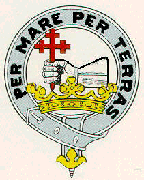The Rise and Fall of Clan Donald
The Kindom of Dalraida lasted a bit over 300 years. Those 300 years saw it allied with Picts and Britons fighting against Angle incurions into Northumbria and southern Scotland. At other times it fought against the Picts and Britons. Sometimes Dalraida extracted tribute from its neighbors. At other times it was forced to pay tribute. It was under Dalraidic rule that St. Columba established the great Celtic religious center on Iona. While the rest of Europe was undergoing its Dark Ages, the Celts of Ireland and Scotland enjoyed a period of culture and learning--with lots of fighting, of course.
Then, at the end of the eighth century and early in the ninth, disaster struck in the form of the Vikings. In the mid-ninth century, the Dalraidic leader, Kenneth Mac Alpin, under pressure from Viking occupation of the Hebrides, transfered the seat of Dalraidic kings to Scone and became the first King of Scotland. The Vikings controlled the Hebrides and the northern and western Highlands until their power was broken in the eleventh century, first at Clontarf (A.D. 1014) in Ireland and then at Stamford Bridge (A.D. 1066) in England.
Although Viking power was broken, they remained in control of the Hebrides and the western Highlands until the 12th century when a Celtic leader named Somerled began accumulating lands and power. Somerled's name was Viking, but he claimed descent from Conn of the Hundred Battles and Fergus Mac Erc. He led a great Celtic revival in the area formerly known as Dalraida, and is the true founder of Clan Donald. Somerled's power was based on his galleys which, though smaller than Norse long ships, were technologically superior. His ships used rudders rather than steering oars which made them more manueverable, and fighting tops which enabled his archers to fire down on the warriors of opposing ships. Somerled's kingdom, in the southern Hebrides and the western shores of Scotland, was still nominally under the Norwegian king. Scotland did not get the Hebrides from Norway until 1266.
Somerled was succeeded by his sons which included Ranald, better known for his piety than his military prowess. Ranald's son, Somerled's grandson, was Donald, after whom Clan Donald is named. Donald's sons included Angus Mor (Big Angus). Angus Mor's son was another Angus, Angus Og (Young Angus).
Angus Og married Agnes O'Cahan, daughter of the great Irish Lord of Limvady who was a descendant of Niall of the Nine Hostages and ruled in Derry. Her dowry included 140 men out of every surname in the O'Cahan territory. Among the families coming to the Highlands in this group are said to have been the MacBeths who later became the Beatons.
During the struggle for Scottish independence that led to the Battle of Bannockburn, Angus Og supported Robert the Bruce. Indeed, in 1306, when Bruce was on the run and virtually without friends, Angus Og sheltered him on an island off the Irish coast. In the spring, Bruce returned to Scotland and resumed the struggle for independence. At the Battle of Bannockburn, in 1314, Angus Og, leading the men from the Hebrides, was greeted by Bruce with, "My hope is constant in thee." The Scottish army was badly outnumbered but routed and slaughtered the English army, largely due to Bruce's intelligent selection of terrain and tactics that negated the English advantage in heavy chivalry.
After Bannockburn, Bruce confiscated territories from his enemies and distributed them among his supporters, including Angus Og. Angus's son, John, added extensively to his holdings through marriages and royal favor and was the first to formally bear the title, Lord of the Isles. John's grandson, Alexander, the third Lord of the Isles, added the earldom of Ross, including the island of Skye and extensive northern Highland holdings, to his territory. But, that was the beginning of the end. The fourth Lord of the Isles, another John, was strong enough to challenge the Scottish crown, but not strong enough to win. In 1493 he was forced to resign his title. All of the chiefs of the various branches of Clan Donald received their lands directly from the king, not through a single lord.
That did it. Without a single recognized leader Clan Donald fell prey to internal feuds and to the rapacity of the Campbells, who did follow a single leader and, moreover, cultivated Lowland connections. The difference between the two clans was striking. Clan Donald had always thought of itself as independent of any Scottish king. Clan Campbell used the authority of the Scottish king to further its own ends. Clan Donald fought against the Stuarts until the Stuarts were no longer kings, and then supported their pretentions. This was the road to Culloden and the Highland Clearances.
It is no joy without Clan Donald:
It is no strength to be without them;
(a lament of Clan Donald)
It all started with Conn of the Hundred Battles, High King of Ireland at Tara. Conn lived in the second century A.D. He may have effectively ruled little more than he could see from the walls of Tara. A great-grandson of Conn was a third century Irish chieftain called Cairbre Riada of the Liffey. He established a kingdom on the shores of northern Ireland called Dal-Riada, or "Riada's Share." Cairbre Riada's great-grandson was Fergus Mac Erc or Fergus Mor (Fergus son of Erc or Big Fergus). It is Fergus Mor who established a kingdom in what is now southwestern Scotland and the southern Hebrides called Dalraida in about 500 A.D. With Fergus came a tribe of Celts called the Scotti.
This site created by Harry E. Connors III
Music is Lord MacDonald sequenced by Barry Taylor
Please e-mail me with any additions, corrections, and comments.
The MacDonald Crest


This page last modified on Sunday, November 25, 2007